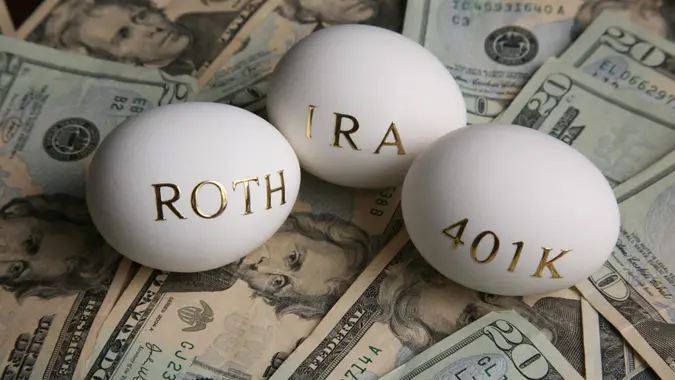Early Retirement: 5 Top Withdrawal Strategies

Commitment to Our Readers
GOBankingRates' editorial team is committed to bringing you unbiased reviews and information. We use data-driven methodologies to evaluate financial products and services - our reviews and ratings are not influenced by advertisers. You can read more about our editorial guidelines and our products and services review methodology.

20 Years
Helping You Live Richer

Reviewed
by Experts

Trusted by
Millions of Readers
Planning for early retirement requires not only saving enough but also strategizing how to withdraw your funds in a tax-efficient manner. The right withdrawal strategy can significantly impact the longevity of your retirement savings and the taxes you pay.
What Is the Best Withdrawal Strategy for Early Retirement?
The best withdrawal strategy for early retirement often involves a balance between minimizing taxes and ensuring your savings last. A popular approach is a proportional withdrawal strategy, which involves taking money from all your accounts — taxable, tax-deferred and tax-exempt — in a way that spreads out the tax impact over time. Here’s a closer look at withdrawal strategies to consider, each tailored to different retirement goals and financial situations.
Strategy 1: Proportional Withdrawals
Proportional withdrawal is a strategy designed to balance tax implications across various types of accounts:
- Tax-deferred accounts: These include traditional IRAs or 401(k)s where you defer taxes on contributions and earnings until withdrawal. At that point, they are taxed as ordinary income.
- Taxable accounts: Accounts such as brokerage accounts fall into this category. They are funded with after-tax dollars, and taxes on capital gains and dividends are paid in the year they are realized.
- Tax-exempt accounts: This category includes accounts like Roth IRAs, where contributions are made with after-tax dollars. However, withdrawals, including earnings, are generally tax-free.
By withdrawing a portion from each of these account types annually, you can potentially reduce the total taxes paid over your retirement. This method not only extends the life of your portfolio but also allows for more evenly distributed tax management.
Strategy 2: Traditional Account-First Approach
In this strategy, you start with withdrawals from your taxable accounts, then move to traditional accounts before finally tapping into Roth accounts. This method can be advantageous if you anticipate higher taxes in the future or if you want to preserve the tax-free growth of Roth accounts for as long as possible. However, it might result in higher taxes initially due to the tax-deferred nature of traditional accounts.
Strategy 3: Capital Gains Utilization
For retirees expecting substantial long-term capital gains, strategically utilizing taxable accounts first can be beneficial. This approach leverages lower or zero long-term capital gains rates in the early years of retirement, allowing for potentially significant tax savings. Once taxable accounts are depleted, you can switch to a proportional approach for other accounts.
Strategy 4: Roth Conversion Ladders
A Roth conversion ladder involves gradually converting parts of a traditional IRA into a Roth IRA over several years. This strategy can be effective if you expect to be in a lower tax bracket in the early years of retirement. It allows you to pay taxes on the converted amount at a lower rate, and once converted, the money grows tax-free in the Roth IRA.
Strategy 5: Required Minimum Distributions Consideration
For those approaching age 72, it’s important to factor in the required minimum distributions from traditional retirement accounts. Planning withdrawals in a way that considers RMDs can help in managing taxes and avoiding penalties for not taking the required amount.
Final Take
Choosing the right withdrawal strategy for early retirement is crucial for tax efficiency and preserving your savings. It’s essential to consider your tax situation, investment accounts and retirement goals when deciding on a strategy. Consulting with a financial advisor or tax professional is recommended to tailor a withdrawal plan that suits your unique needs in early retirement.
FAQ
Here are the answers to some of the most frequently asked questions regarding retirement withdrawals.- What is the best order to withdraw retirement funds?
- The best order to withdraw retirement funds often depends on your tax situation and financial goals. A common strategy is the following:
- First withdraw from taxable accounts, like regular investment accounts.
- Then from tax-deferred accounts -- such as traditional IRAs and 401(k)s.
- Finally from tax-exempt accounts like Roth IRAs.
- This approach can help minimize taxes over the course of retirement.
- The best order to withdraw retirement funds often depends on your tax situation and financial goals. A common strategy is the following:
- How do early retirees withdraw money?
- Early retirees typically withdraw money using strategies that balance tax efficiency and the need to avoid penalties. This may include withdrawing from taxable accounts first, utilizing Roth IRA contributions and considering Roth conversion ladders.
- Which accounts should you draw from first in retirement?
- Generally, it's recommended to draw first from taxable accounts, as these funds have already been taxed and selling assets may incur only capital gains tax, which is usually lower than regular income tax.
- After depleting taxable accounts, move to tax-deferred accounts to take advantage of lower tax rates in retirement, and finally, draw from tax-exempt accounts like Roth IRAs, which allow tax-free withdrawals.
- Is it better to withdraw monthly or annually from a 401(k)?
- Whether it's better to withdraw monthly or annually from a 401(k) depends on your personal cash flow needs and tax situation. Monthly withdrawals can provide a steady stream of income, similar to a paycheck, which can be helpful for budgeting. Annual withdrawals might be beneficial if you have other income sources and prefer to strategize your withdrawals for tax purposes at specific times of the year.
Editor's note: This article was produced via automated technology and then fine-tuned and verified for accuracy by a member of GOBankingRates' editorial team.
Our in-house research team and on-site financial experts work together to create content that’s accurate, impartial, and up to date. We fact-check every single statistic, quote and fact using trusted primary resources to make sure the information we provide is correct. You can learn more about GOBankingRates’ processes and standards in our editorial policy.
- Fidelity. 2023. "Tax-savvy withdrawals in retirement."
 Written by
Written by 

























